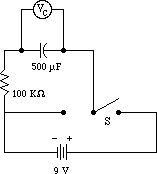

RC Circuits
INTRODUCTION
The purpose of this experiment is to gather data by charging and
discharging capacitors in a series RC circuit, then to examine
some of the properties of exponential functions.
THEORY
 Exponential functions occur in all branches of science; here are
some of their important properties:
Exponential functions occur in all branches of science; here are
some of their important properties:
- They have a characteristic time often denoted by tau
(τ).
- In any time interval equal to tau, a decaying exponential
decreases to 37% of its initial value.
- An increasing exponential rises from zero to 63% of
its final value in time tau.
EXPERIMENT
- Connect the circuit shown so that you can charge and discharge
the capacitor.
- Charging: Set your voltmeter so that it reads to 0.01
volts DC. Measure the voltage across the capacitor every 10
seconds for 200 seconds after closing the switch to charge
the capacitor. Leave the voltage on and record its value
after it stops changing (Vmax). Record your data using a table
as shown.
|
Capacitor Charging
|
Capacitor Discharging
|
Elapsed Time
(sec)
|
Vc
(volts)
|
Elapsed Time
(sec)
|
Vc
(volts)
|
lnVc
|
|
0
|
0
|
0
|
|
|
|
10
|
|
10
|
|
|
|
20
|
|
20
|
|
|
|
…
|
|
…
|
|
|
|
200
|
|
200
|
|
|
- Discharging: Repeat step 2, moving the switch so that
you discharge the capacitor, recording the voltage across
the capacitor every 10 seconds.
ANALYSIS
- Plot three graphs of your data (all as a function of time):
the charging voltage across the capacitor; the discharging voltage;
and the ln (natural log) of the discharging voltage.
- Find values of tau from (i) your charging graph (the
amount of time to 63% of Vmax), (ii) the discharging graph
(time to 37% of Vmax) and (iii) from the slope of
the log graph. For (iii) you need to know that
- Vc = Vmaxe( –t/tau )
- lnVc = lnVmax – t( 1/tau )
Compare step (b) with y = b + mx (for a straight line), and calculate
tau from the slope.
- Find the expected value of tau from τ = RC (Note: you
are using 500 microFarad capacitors. Some are marked 500 µF, while
others use the older notation of 500 mFd. Both are equivalent!).
- Use the computer to determine a value for tau, using both the
charging and discharging data. Since it has been awhile since
the computer was used, your instructor will assist you.
REPORT
- Present your six values for tau; you should clearly indicate
the source of each result.
- Discuss if the six estimates for tau are consistent; if not, try
to explain why.
- What assumptions did you have to make in step 6? How can you
check your assumptions? Be sure to check.
- Finally, use the log graph and the fit of the computer line to
your data to show whether or not your data for the discharge curve
are exponential (explain your logic!).
Return to Physics 104
|
|
©
|
St. Lawrence University |
Department of Physics |
|
Revised: 16 May 17
|
Canton, NY 13617
|
 Exponential functions occur in all branches of science; here are
some of their important properties:
Exponential functions occur in all branches of science; here are
some of their important properties:
 Exponential functions occur in all branches of science; here are
some of their important properties:
Exponential functions occur in all branches of science; here are
some of their important properties: